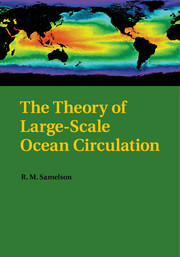Book contents
- Frontmatter
- Contents
- Preface
- 1 Basic Physical Principles and Equations
- 2 Reduced Equations for Large-Scale Motion
- 3 Planetary Geostrophic Vorticity Dynamics
- 4 Stratified Large-Scale Flow
- 5 Circulation in a Simple Rectangular Basin
- 6 Eddy-Driven Subsurface Motion
- 7 Circumpolar Flow
- 8 Mid-Depth Meridional Overturning
- 9 Thermohaline Effects
- 10 Theory and Observation
- Exercises
- References
- Index
10 - Theory and Observation
Published online by Cambridge University Press: 07 October 2011
- Frontmatter
- Contents
- Preface
- 1 Basic Physical Principles and Equations
- 2 Reduced Equations for Large-Scale Motion
- 3 Planetary Geostrophic Vorticity Dynamics
- 4 Stratified Large-Scale Flow
- 5 Circulation in a Simple Rectangular Basin
- 6 Eddy-Driven Subsurface Motion
- 7 Circumpolar Flow
- 8 Mid-Depth Meridional Overturning
- 9 Thermohaline Effects
- 10 Theory and Observation
- Exercises
- References
- Index
Summary
A Perturbation-Theoretical Perspective
The basic point of view around which the development in this text has been organized is that of perturbation theory. In general, perturbation theory allows the replacement of a difficult or intractable problem with a simpler approximation that includes the leading-order terms in an expansion of the original variables in powers of a suitable small parameter. In the present case, a formal expansion was not necessary because the effective leading-order terms for large-scale ocean circulation dynamics could be identified by direct scaling of terms in the fundamental equations. These leading-order terms—the perturbation theory for the large-scale ocean circulation–are the planetary geostrophic equations (2.102)–(2.107).
The planetary geostrophic theories of large-scale circulation described in this text provide deep, quantitative insight into the large-scale physical structure of the ocean. For example, the reduced-gravity and ventilated thermocline models (Chapter 5) give persuasive explanations for the basic structure of the upper main subtropical thermocline, including the characteristic downward and westward slope of thermocline isosurfaces (Figure 1.7). Similarly, the Sverdrup interior solution (3.36) for the depth-integrated wind-driven transport may be favorably compared with interior geostrophic transports determined from hydrographic measurements.
Given a solution of an approximate problem constructed using perturbation theory, one would like to know how accurately it represents the solution of the original problem. If the original problem cannot be solved theoretically by other means, as is the case with large-scale ocean circulation, then the comparison must be made to observations of the system under consideration.
Information
- Type
- Chapter
- Information
- The Theory of Large-Scale Ocean Circulation , pp. 164 - 170Publisher: Cambridge University PressPrint publication year: 2011
